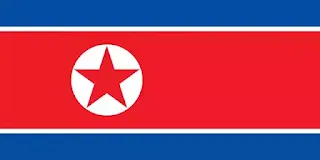Decoding the Symbolism: The North Korean Flag
Flags are not merely pieces of cloth; they are powerful symbols representing the identity, values, and aspirations of nations. Among the world's flags, few are as enigmatic and loaded with symbolism as the flag of North Korea. This emblem, with its striking design and carefully chosen elements, offers a window into the ideology and aspirations of the secretive regime that governs the Democratic People's Republic of Korea (DPRK).
A Brief Overview:
The flag of North Korea, also known as the Ramhongsaek Konghwagukgi, consists of three main components: a wide red stripe in the center, bordered by a narrow white stripe on each side. In the upper left corner, there is a blue-colored disc, encircling a white star. This flag has remained unchanged since its adoption on September 8, 1948, shortly after the establishment of the DPRK.
Decoding the Symbolism:
Red Stripe: The prominent red stripe dominates the flag, symbolizing revolution, socialism, and the sacrifices made for the nation's independence. Red has long been associated with communism, and in the context of North Korea, it represents the ideology of Juche, the state's official guiding principle emphasizing self-reliance and independence.
White Stripes: Flanking the red stripe on both sides, the white stripes symbolize purity and peace. However, they also serve a practical purpose, providing a visual contrast that enhances the visibility of the central red band.
Blue Disc: Positioned in the upper left corner, the blue disc signifies the country's struggle against imperialism. The shade of blue used is often referred to as "Pantone 287C," and it's deeply associated with anti-imperialist movements. It encapsulates the determination of North Korea to resist external influence and maintain its sovereignty.
White Star: Within the blue disc lies a five-pointed white star. This star is a universal symbol of socialism, representing the unity of the Korean people under the leadership of the Workers' Party of Korea. Each point of the star symbolizes one of the five core principles of Juche ideology: independence, self-sustainability, nationalism, democracy, and peace.
Historical Context:
Understanding the symbolism of the North Korean flag requires insight into the country's history and political ideology. The flag's design reflects the ideals of the ruling Workers' Party of Korea, founded by Kim Il-sung, the country's first supreme leader. Kim Il-sung's regime utilized symbolism extensively to foster loyalty and reinforce its narrative of resistance against imperialism and capitalism.
In conclusion, the flag of North Korea is far more than a mere piece of cloth. It's a powerful emblem that encapsulates the nation's history, ideology, and aspirations. From its bold colors to its carefully chosen symbols, every element of the flag tells a story of defiance, resilience, and national identity. While often viewed with curiosity and even apprehension by the outside world, the North Korean flag remains a potent symbol of the regime's enduring grip on power and its commitment to its unique brand of socialism.



